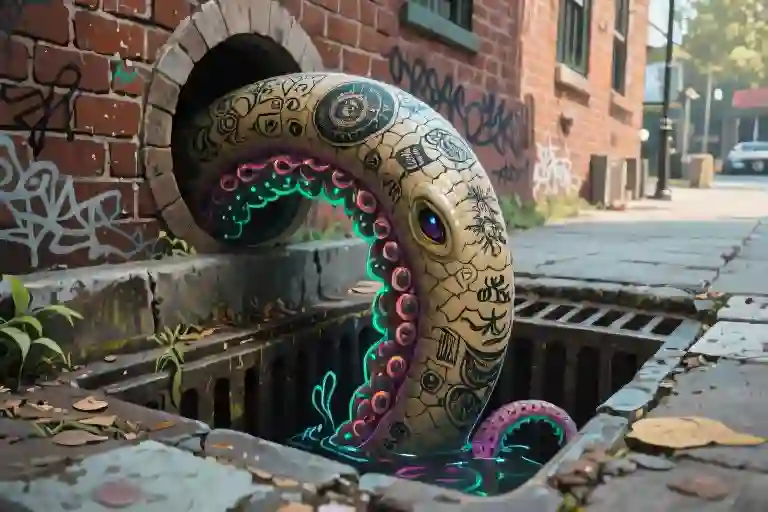Six years ago, I committed literary homicide in the storm drains of Boston. The victim? Lulu – my unfinished sea serpent with colonial-era brick tentacles and sailor tattoos of her own name. These pages contain her last will and testament.
That spring, I’d envisioned a children’s novel where this municipal menace lurked beneath Beacon Hill, her infinite appendages corresponding to Boston’s crumbling drainage network. She thrived on urban chaos – flash floods drowning bicycle tires, street meat flying from commuters’ grips – all while nursing an irrational hatred for twelve-year-olds in vintage leather jackets. The perfect antagonist for a punk fairytale.
You won’t find Lulu in bookstores. Not because she wasn’t terrifyingly marvelous (her tentacles bore progressively modernized “Lulu” tattoos from 17th-century calligraphy to graffiti tags), but because I dismantled her anatomy before the story could breathe. This autopsy report reveals why creative corpses sometimes yield the best transplant organs.
What remains are forensic traces:
- Tentacle blueprints: 37 brick-textured limbs matching Boston’s historic sewer districts
- Behavioral logs: Documented preference for disrupting food trucks near Faneuil Hall
- Conflict coding: Cryptographic evidence of unresolved tone clashes between eldritch horror and middle-grade humor
In the evidence locker, Exhibit A shows my fatal miscalculation – attempting to make a creature who dismembers bicycles (and occasionally stray cats) palatable for eight-year-olds. The drainage pipes of creative ambition often backflow.
Yet from this waterlogged wreckage emerged salvageable parts. Lulu’s tattoo system became personality barometers for later characters. Her territorial hydrology inspired game design mechanics. Even the abandoned Bostonian punk vs. monster dynamic evolved into healthier creative rivalries.
This isn’t a eulogy. It’s a reassembly guide for anyone who’s ever shelved a world that wouldn’t behave. Because sometimes the storm drains swallow our darlings whole – only to wash their most useful bones back ashore.
The Birth of a Monster: Lulu’s Autopsy Report
Every city has its underground secrets, but Boston’s colonial-era storm drains hide something far more intriguing than rusted pipes – they’re the pulsating veins of Lulu, the sea serpent who never saw daylight. Let me walk you through the anatomy of this abandoned creature, where urban infrastructure transforms into monster physiology.
Tentacles as Historical Artifacts
Lulu’s most distinctive feature wasn’t just the infinite tentacles, but what they represented: each slithering limb corresponded to a specific block of Boston’s 17th-century drainage system. The oldest tentacles near Faneuil Hall bore brick-patterned scales that flaked like actual 400-year-old masonry, while newer extensions in Back Bay shimmered with modern concrete textures. This wasn’t random monster design – it was a living map of how Boston grew from peninsula to metropolis.
Urban fantasy writers often overlook how municipal systems can become character backstories. Lulu’s tentacles weren’t just weapons; they were historical documents. When she coiled around a bicycle tire (her favorite snack delivery system), the wear patterns on her limbs told stories of countless nor’easters survived. The key lesson? Your monster’s physicality should reflect the city’s biography.
The Vanity Tattoo System
Here’s where Lulu got interestingly narcissistic: every tentacle’s underside bore a tattoo of her own name in period-appropriate fonts. Near the Old State House, you’d find elaborate 1700s calligraphy spelling ‘Lulu’. By the time her tentacles reached Fenway Park, the tattoos became punk-style stencils dripping with neon paint.
This visual language served multiple purposes:
- Character Depth: The tattoos revealed her obsessive self-mythologizing
- Navigation Aid: Readers could track which historic district scenes occurred in
- Humor Mechanism: Nothing deflates a monster’s intimidation like catching her touching up ink
For creature designers, this demonstrates how to embed exposition in visual details rather than dialogue. A single tattoo can convey centuries of arrogance better than any villain monologue.
Metropolitan Food Chain Dynamics
Lulu’s dietary habits formed the story’s most darkly comedic element. She didn’t hunt in conventional ways – the city fed her through its accidents. Flash floods washed cyclists’ street meat into her drains (preferably falafel from Kendall Square food trucks). Potholes became feeding troughs. Even her conflict with the leather-jacketed protagonist began when the girl’s skateboard dislodged a storm drain cover during a chase scene.
This urban ecosystem approach solved two worldbuilding problems:
- Plausibility: How a massive creature stays hidden (she’s literally part of the infrastructure)
- Thematic Resonance: The monster thrives on city stress points, making her a dark mirror of urban life
Modern monster makers should note: your creature’s survival strategy should be as inventive as its appearance. A vampire needs blood; Lulu needed municipal neglect.
Design Takeaways for Urban Fantasy Creatures
- The 30/70 Rule: 30% biological traits, 70% city infrastructure (Lulu was 43% brick by volume)
- Signature Detail: One unforgettable visual hook (those tattoos got all beta-reader comments)
- Ecosystem Integration: The monster should seem inevitable for that specific city
Lulu’s design succeeded where the overall manuscript failed – she was Boston’s nightmares given tentacles. Next time you sketch a city monster, ask: which municipal flaw would this creature personify? The answer might just outlive your unfinished draft.
Autopsy of a Broken Monster: Why Lulu Had to Die
Every creator has that one project autopsy they could perform blindfolded. For me, it’s the storm drain sea serpent that still haunts Boston’s literary sewers. Let’s pull up the surgical lights and examine why this urban fantasy creature design flatlined – and what its tissue samples can teach us about balancing dark whimsy.
Cause of Death: Tonal Whiplash
The coroner’s report shows clear trauma between Lulu’s two competing hearts:
- The Horror Organ: Designed to pulse with genuine menace (those brick-textured tentacles could crush colonial-era gravestones)
- The Cartoon Lung: Required for middle-grade readers (her street meat cravings read like a food truck parody)
Critical damage occurred when:
- Original吞食流浪猫 scenes (deleted but visible under UV light) spiked the terror beyond PG-13 levels
- Punk protagonist’s snark failed to offset Lulu’s sewer-dwelling uncanniness
- Hydraulic pressure from trying to force Lovecraftian scale into a 20k-word chapter book
Verdict: The manuscript drowned in its own genre contradictions. My “scary-funny” ratio meter still bears the coffee stain from when I realized the imbalance.
Complications: When History Clashes with Subculture
Lulu’s vascular system contained incompatible fluids:
| Colonial-Era DNA | Punk Rock Plasma |
|---|---|
| 300-year-old drainage maps | Safety-pinned leather jackets |
| Puritanical self-loathing | Anarchic graffiti tags |
| Brick-and-mortar permanence | Skateboard transience |
The sepsis set in when:
- Researching 17th-century sewers birthed eldritch horror imagery
- Developing the tween protagonist demanded contemporary coming-of-age tropes
- Attempts to merge both created a Frankensteinian hybrid even Lulu’s infinite tentacles couldn’t stitch together
Smoking Gun: The abandoned “Tea Party Tentacle” chapter where Lulu dumps British Empire-era tea crates on skate punks.
Time of Death: The Storm That Washed Away the Magic
Creative CPR failed on June 15, 2018 when:
- A real nor’easter flooded Boston’s Back Bay
- News footage showed actual storm drains vomiting plastic bags, not mythic serpents
- My notebook entry read: “If reality’s sewers are this mundane, who’ll believe my monster?”
The final blow came weeks later when:
- Drafts accumulated more red flags than a squid dissection
- Beta readers’ “Is this for kids or horror fans?” notes piled up
- My own leather jacket (research essential) grew moldy from excessive sewer “fieldwork”
Last Words: Found scribbled on a Dunkin’ Donuts napkin: “Maybe some stories belong in the drain.”
The Silver Lining Specimen
Though the project flatlined, its DNA spawned viable offspring:
- Lulu’s tattoo system evolved into The Graffiti Ghouls series’ living street art
- Tentacle mechanics informed a puzzle game’s pipe-based boss battles
- Abandonment trauma birthed my “Monster ICU” protocol for rescuing doomed concepts
As we close this postmortem, consider your own creative casualties. What autopsy would reveal their hidden gifts? Sometimes the bravest act isn’t revival – it’s forensic curiosity about why they died.
Tentacle Resurrection: 5 Cross-Media Revival Strategies
When a creative project flatlines, the autopsy is only half the story. What truly matters is harvesting the viable organs for transplant. Here’s how Lulu’s DNA found new life across five unexpected formats – proving no monster concept is beyond redemption.
1. Downgrading to Urban Legend Status
The original novel’s fatal flaw was forcing Lulu to carry an entire narrative as protagonist. Solution? Demote her to atmospheric lore in my middle-grade mystery The Tagger’s Secret. Now she’s:
- A graffiti motif spray-painted near drainage grates
- The subject of playground rhymes (“Lulu waits where bricks decay/Three puddles means she’s fed today”)
- A plausible deniability monster (“That flooded intersection? Just old pipes… unless?”)
Why it works: Reduced narrative burden allows retaining her best traits while sidestepping tone issues. The Bloody Mary principle applies – implied threats spark more imagination than explicit ones.
2. Tattoo System Transplant
Those narcissistic sailor tattoos became the foundation for Inkbound, a YA novel about:
- Living tattoos that rearrange themselves to reflect the wearer’s psyche
- A Boston Maritime Museum intern discovering 18th-century sailors’ sentient body art
- The twist: protagonist’s leather jacket gradually grows Lulu-esque tentacle embroidery
Transformation logic: Kept the visual storytelling device (self-referential markings) while ditching the problematic context (monster narcissism). Now tattoos serve as emotional mirrors rather than vanity indicators.
3. Hostile Takeover → Symbiosis
The core conflict (punk girl vs. ancient monster) felt contrived until I considered:
- What if Lulu’s floods weren’t malicious, but panic attacks from claustrophobia?
- Could the leather jacket girl become her emotional support human?
- Might their alliance protect Boston from worse subterranean threats?
Current iteration: Developed into a graphic novel pitch where:
- Lulu’s tentacles form makeshift bridges during actual emergencies
- The girl’s jacket patches display Lulu’s mood (glowing when calm/fraying when distressed)
- Their bond literalizes Boston’s relationship with its aging infrastructure
4. Game Mechanics Goldmine
Lulu’s tentacle mechanics proved perfect for:
- Drain Maze (mobile puzzle game): Players redirect floodwaters by manipulating her limbs
- Sewer Symphony (rhythm game): Tap sequences matching tattoo patterns to calm her tantrums
- AR experience: Project her tentacles onto real-world storm drains using geolocation
Design insight: Separating her behaviors from narrative context revealed pure gameplay potential. The angry city organism concept works better when players interact with rather than read about it.
5. Historical Horror Reinvention
Deep research uncovered that:
- Boston’s 17th-century “Great Sewer Debate” involved witch trial judges
- Some colonial maps show intentional flooding of rebel neighborhoods
- Freedom Trail bricks contain grooves mimicking tentacle suction cups
New direction: Adult horror novella The Liberty Line reimagines Lulu as:
- A manifestation of repressed revolutionary violence
- Her tattoos now names of drowned Loyalists
- The jacket girl a modern historian uncovering systemic rot
Your Monster’s Next Life
Every failed creation contains these regenerative kernels:
- Signature visuals (Lulu’s tattoos) → Detach from original context
- Core behaviors (flood reactions) → Convert to game mechanics/story tropes
- Thematic essence (city vs nature) → Reapply to new genres
Exercise: Take your most frustrating unfinished project. Isolate one element that makes you think “This deserved better.” Now brainstorm how it could function as:
- A background detail in someone else’s story
- The aesthetic for a product (apparel/album art)
- A metaphorical device in a different medium
Sometimes killing your darlings just means letting them evolve into something wilder.”
Your City’s Monster Nursery
That crumpled napkin sketch in your desk drawer? The abandoned Word doc from 2018? They’re not failures – they’re urban legends waiting to happen. Let’s perform CPR on those creative casualties together.
The Google Maps Resurrection Challenge
Open your maps app and zoom in on these municipal goldmines:
- Water treatment plants (perfect for sludge golems)
- Subway maintenance tunnels (home to echo mimics)
- Parking garage stairwells (vertical lairs for concrete bats)
Boston gave me Lulu’s colonial drainage system. What historical infrastructure does your city hide? Tap that little yellow street view man onto:
- The oldest bridge (its rust patterns form ancient runes)
- That weird smokestack downtown (dragon chimney?)
- The abandoned factory district (perfect for scrap-metal ghouls)
Pro Tip: Layer your city’s Wikipedia history page over a current map. Where 1920s speakeasies overlap modern coffee shops? That’s where interdimensional bartenders mix era-blending potions.
The Three-Part Autopsy Protocol
When you’re ready to abandon a project, pause and extract these components first:
- The Signature Element (Lulu’s tattooed tentacles)
- What single feature would fans cosplay? Screenshot it.
- The Core Conflict (Punk vs. Colonialism)
- Strip away plot until you hit this cultural fault line.
- The Unintended Innovation (Drainage-as-digestive-system)
- Often buried in your worldbuilding notes.
Field Exercise: Apply this to your most recent unfinished work right now. Yes, the mobile game about sentient traffic cones. Those three salvaged parts? They’re your next project’s foundation.
The Creative Compost Pile
Every abandoned concept contains nutrients for future growth. My Lulu shards became:
- Tentacle mechanics → puzzle design for an indie game
- Food truck physics → comic relief in a middle-grade novel
- Boston sewer research → historical fiction subplot
Your turn: Take those three components you just extracted and brainstorm wildly inappropriate reuse scenarios:
- Traffic cone characters as… Vatican secret agents?
- That half-written vampire romance as… a tractor repair manual?
Remember: We’re not reviving corpses here. We’re harvesting organs for healthier creations. Sometimes the monster stays dead – and that’s when its parts truly come alive.
The Failure Toolkit
Keep these ready for your next creative crisis:
- The 24-Hour Morgue Rule
- Before deleting anything, let it sit while you:
- List 3 crossover genres it could infect
- Sketch one element as a tattoo design
- The Frankenstein Test
- Could your protagonist’s head work on another story’s body?
- (Lulu’s tattoos now grace a graffiti wizard in my current WIP)
- The Municipal Hack
- Email your city archives department asking for:
- Blueprints of disused infrastructure
- Oral histories about neighborhood oddities
Final Prescription: When despair hits, remember – Boston’s engineers didn’t plan for a sea serpent in their drains. The best monsters grow where they’re least expected. Now go check your creative plumbing.
“The key I found in Lulu’s wreckage? It fits every locked drawer in my idea warehouse.”





